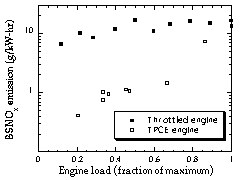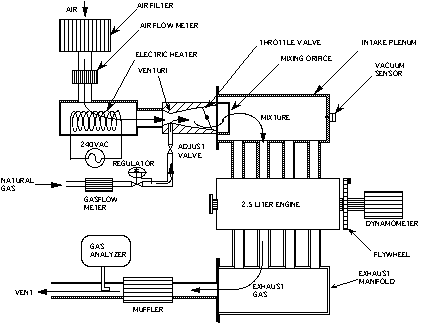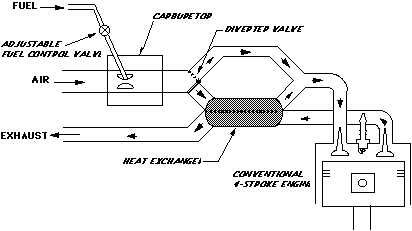Throttleless Premixed-Charge Engines
References
3. Ronney, P.
D., Shoda, M., Waida, S. T., Westbrook, C. K., Pitz, W. J., “Knock
Characteristics of Liquid and Gaseous Fuels in Lean Mixtures,” Transactions of
the Society of Automotive Engineers, Vol. 100, Part 4, pp. 557-568 (1992). Also
SAE Paper No. 912311, 1991.
Why
throttleless premixed-charge engines?
Conventional
premixed-charge spark-ignition engines employ a throttle to reduce power and
torque when demand is low by reducing the pressure of the combustible mixture
drawn into the cylinder. This results in the well-known “throttling loss.”
Under typical highway cruising conditions, this loss is typically 15% or more of
the otherwise available power output of the engine. This loss leads to reduced
fuel economy and increased pollutant emissions.
We have
developed an engine control concept, called the Throttleless Premixed Charge
Engine (TPCE), which provides the necessary range of power and torque
adjustment without throttling by using a combination of lean mixture and
intake air preheat to adjust torque. Higher intake temperatures reduce the air
density and thus power and torque. Leaner mixtures also reduce power and torque,
and the intake air preheat substantially reduces the lean misfire limit. Thus in
the TPCE concept the synergistic use of preheating and lean mixtures is
essential;
neither technique individually provides a sufficient range of power and torque
adjustment for use in practical motor vehicles.
A detailed
discussion of the concept, testing and implementation of the TPCE engine is
given in our technical paper [1] that won the British Institution of Mechanical
Engineers Starley Premium Award for the best paper published in the Journal of
Automobile Engineering in 1994. Also, we have been granted a U.S. patent (No. 5,184,592) for the concept. A brief
summary of our work is presented here. Our current work, supported by the South Coast Air Quality Management District and
the National Center for Metropolitan Research
(METRANS), is discussed at the bottom of this page.
Applications
of the Throttleless Premixed Charge Engine concept
The TPCE
concept is ideal for vehicle applications because vehicles are constantly
changing load and speed, and are only infrequently operated at wide-open
throttle. In this sense the TPCE concept provides many of the best aspects of
premixed-charge, spark-ignition engines (fast response time, high power to
weight ratio, and negligible particulate emissions) with the best aspect of
nonpremixed-charge compression-ignition (Diesel-type) engines (higher part-load
thermal efficiency due to lean operation without a pressure-reducing throttle). For these reasons the
TPCE concept is equally applicable to light-duty vehicles as well as heavy-duty
trucks and buses.
The TPCE system
is easy to retrofit to existing engines because only a change of the intake,
exhaust, and engine control systems is required for the basic installation. Of
course, engines specifically designed for the TPCE application would realize
more substantial performance gains.
Summary
of results to date
We conducted
experiments to test the TPCE concept using 4-cylinder production engines with
natural gas fuel. As shown in Figure 1, these tests showed the theoretically
expected level of improvement in brake thermal efficiency (up to 16% compared
to the same engine operated using conventional throttle control at same power
and engine speed) due to the absence of throttling loses. Also, because of lean
operation, greatly reduced NOx emissions are obtained - typically 10
times lower than the same engine operated using conventional throttle control
at same power and engine speed (see Figure 2). The observed NOx
level of less than 0.8 grams of NOx per kW-hr (0.6 grams per hp-hr)
at moderate and light loads corresponds to less than 0.2 grams per mile for a typical
15 hp road load at 55 mi/hr – without the use of a reducing catalytic
converter for NOx removal. This emission level is half of the 2001
California standard, and equal to the 1998 “Clean Fleet” standard required for
30% of new vehicles used by centrally-fuelled fleets in cities with poor air
quality. CO and unburned hydrocarbon emissions in TPCE engines were found to be
comparable to throttled engines, thus only inexpensive oxidizing catalysts for
CO and UHC are needed for TPCE engines. Torque control via exhaust gas
recirculation (EGR) was also tested and found to have similar NOx
characteristics but vastly inferior thermal efficiency and torque adjustment
range.
|
|
|
|
Figure 1. Comparison
of brake thermal efficiency of throttled and throttleless (TPCE) engines using
natural gas fuel. Experiments employed a 4-cylinder 2.5 liter General Motors
LX8 engine. |
Figure 2. Comparison
of measured brake specific NOx (BSNOx) emissions of
throttled and throttleless (TPCE) engines using natural gas fuel. Note
logarithmic scale on BSNOx. |
Current
efforts
In the TPCE and
throttled engine experiments described above, the engine was operated in a
manner compatible with vehicle applications in all aspects except one: for experimental
convenience the air was preheated using an electrical heater (see Figure 3),
whereas in a practical application the air preheat must of course be
accomplished via heat exchange with the exhaust gas. A practical means of
providing rapidly controllable, variable air preheat is proposed for assessment
in this work (see Figure 4.) In this scheme a diverter valve and branched
intake duct, one branch passing through the heat exchanger and the other
bypassing the heat exchanger, is used. By adjusting the diverter valve
position, cold mixture is always available without delay when the torque demand
(commanded by the driver or cruise control system) increases suddenly. Thus,
good dynamic performance characteristic of throttled engines is maintained despite
the unavoidable thermal lag associated with heat exchangers. An additional
advantage of this scheme is that only one additional moving part (the diverter
valve) is needed. A simple computer analysis of a concentric tube-bundle
counterflow heat exchanger indicates that an exchanger composed of 50 tubes,
each 4 millimeters in diameter and 40 cm long would suffice for a 2.5 liter
test engine. The overall size of the heat exchanger would be about 5 cm in
diameter and 40 cm long, which is readily accommodated under the hood of modern
vehicles. The pressure drop across the exchanger would be less than 0.05 atm,
that is, much less than that due to throttling. Consequently, in the proposed
study the viability of the heat exchanger / branched manifold / diverter valve
scheme for control of TPCE engines will be assessed with respect to emissions
performance, thermal efficiency, and dynamic response.
|
|
|
Figure 3. Schematic diagram of existing engine
test facility at USC using electrical preheat of intake air (gaseous fuel
implementation shown; liquid fuel configuration also available.) |
|
|
|
Figure 4. Proposed implementation of TPCE
using heat exchanger and diverter valve to control inlet temperature and thus
torque output. (Carbureted gaseous fuel system shown; fuel injection system
to be used for liquid fuels). |
In the TPCE
system, three engine operating parameters need to be controlled: mixture ratio,
intake temperature and ignition timing. This wide control parameter space allows
the engine performance to be optimized for lowest emissions while maintaining
good fuel economy. For example, lean operation reduces NOx emissions
but may lead to unacceptably poor efficiency due to misfire if the engine is
operated too lean. Also, elevated intake temperatures are advantageous because
of the wider flammability limits and lower intake mixture density this entails,
but too high intake temperatures will result in destructive engine knock (see
issue 2 below). In the proposed work we will determine the proper program of
control parameters for both static and dynamic engine operation, including
transient conditions such as acceleration and deceleration.
Since the TPCE
concept requires the use of lean mixtures and preheating of the intake air,
TPCE engines are in general limited by lean-limit fuel performance and engine
knock (sometimes called “autoignition,” “detonation” or “pinging”) which is
more prevalent at elevated intake temperatures [2]. For these reasons
conventional fuels such as gasoline, which have relatively poor lean-limit
performance and knock characteristics, do not perform well in TPCE engines [1].
However, by using natural gas fuel, which has excellent lean-limit performance
and anti-knock properties even at elevated temperatures, the required range of
torque adjustment was demonstrated [1]. Somewhat unexpectedly, lean mixtures
exhibited excellent resistance to engine knock compared to stoichiometric
mixtures. This is significant because the intake charge preheating used in the
TPCE concept might have worsened knock problems, but for lean mixtures our
research has shown that this is not the case. An important implication of these
results is that optimal fuels for TPCE engines may be different from those of
conventional stoichiometric-burning throttled engines.
As a results of
these findings, we will examine the performance of other alternative fuels such
as methanol, ethanol and hydrogen in TPCE engines. These fuels also have
greatly enhanced lean limit and/or anti-knock performance relative to gasoline
and thus are likely candidates for TPCE operation. In particular, methanol and
ethanol have much higher octane ratings than gasoline blends, and hydrogen has
the lowest lean misfire limit of any fuel. Consequently, the TPCE studies will
be extended to evaluate the performance of these alternative fuels and fuel
blends. These results will be compared to the performance of natural gas fuel,
which has already proven to be an excellent choice for TPCE engines. This work
is being supported by the South Coast Air
Quality Management District and the National
Center for Metropolitan Research (METRANS).



